| This article needs additional citations for verification. Please help improve this article by adding citations to reliable sources. Unsourced material may be challenged and removed. (February 2011) |

Spark plug with single-ground electrode.
A spark plug (very rarely in British English: a sparking plug[1]) is an electrical device that fits into the cylinder head of some internal combustion engines and ignites compressed fuels such as aerosol, gasoline, ethanol, and liquefied petroleum gas by means of an electric spark.
Spark plugs have an insulated central electrode which is connected by a heavily insulated wire to an ignition coil or magneto circuit on the outside, forming, with a grounded terminal on the base of the plug, a spark gap inside the cylinder.
Reciprocating internal combustion engines can be divided into spark-ignition engines, which require spark plugs to initiate combustion, and compression-ignition engines (diesel engines), which compress the air and then inject diesel fuel into the heated compressed air mixture where it autoignites.
Spark plugs may also be used in other applications such as furnaces where a combustible mixture should be ignited. In this case, they are sometimes referred to as flame igniters.
History[]
In 1860 Étienne Lenoir used an electric spark plug in his first internal combustion engine and is generally credited with the invention of the spark plug.
Early patents for spark plugs included those by Nikola Tesla (in U.S. Patent 609,250 for an ignition timing system, 1898), Frederick Richard Simms (GB 24859/1898, 1898) and Robert Bosch (GB 26907/1898). But only the invention of the first commercially viable high-voltage spark plug as part of a magneto-based ignition system by Robert Bosch's engineer Gottlob Honold in 1902 made possible the development of the internal combustion engine. Subsequent manufacturing improvements can also be credited to Albert Champion,[2] the Lodge brothers, sons of Sir Oliver Lodge, who developed and manufactured their father's idea[3] and also Kenelm Lee Guinness, of the Guinness brewing family, who developed the KLG brand.
Operation[]
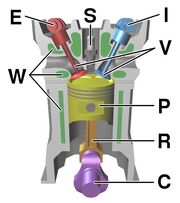
Components of a typical, four stroke cycle, DOHC piston engine. (E) Exhaust camshaft, (I) Intake camshaft, (S) Spark plug, (V) Valves, (P) Piston, (R) Connecting rod, (C) Crankshaft, (W) Water jacket for coolant flow.
The plug is connected to the high voltage generated by an ignition coil or magneto. As the electrons flow from the coil, a voltage difference develops between the central electrode and side electrode. No current can flow because the fuel and air in the gap is an insulator, but as the voltage rises further, it begins to change the structure of the gases between the electrodes. Once the voltage exceeds the dielectric strength of the gases, the gases become ionized. The ionized gas becomes a conductor and allows electrons to flow across the gap. Spark plugs usually require voltage of 12,000–25,000 volts or more to 'fire' properly, although it can go up to 45,000 volts. They supply higher current during the discharge process resulting in a hotter and longer-duration spark.
As the current of electrons surges across the gap, it raises the temperature of the spark channel to 60,000 K. The intense heat in the spark channel causes the ionized gas to expand very quickly, like a small explosion. This is the "click" heard when observing a spark, similar to lightning and thunder.
The heat and pressure force the gases to react with each other, and at the end of the spark event there should be a small ball of fire in the spark gap as the gases burn on their own. The size of this fireball or kernel depends on the exact composition of the mixture between the electrodes and the level of combustion chamber turbulence at the time of the spark. A small kernel will make the engine run as though the ignition timing was retarded, and a large one as though the timing was advanced.
Spark plug construction[]
A spark plug is composed of a shell, insulator and the central conductor. It pierces the wall of the combustion chamber and therefore must also seal the combustion chamber against high pressures and temperatures without deteriorating, over long periods of time and extended use.
Parts of the plug[]
Terminal[]
The top of the spark plug contains a terminal to connect to the ignition system. The exact terminal construction varies depending on the use of the spark plug. Most passenger car spark plug wires snap onto the terminal of the plug, but some wires have spade connectors which are fastened onto the plug under a nut. Plugs which are used for these applications often have the end of the terminal serve a double purpose as the nut on a thin threaded shaft so that they can be used for either type of connection. These are a necessary part of the spark plug.
Insulator[]
The main part of the insulator is typically made from sintered alumina,[4][5]), printed with the manufacturer's name and identifying marks, then glazed to improve resistance to surface spark tracking. Its major function is to provide mechanical support for the central electrode, while also providing an extended spark path for flashover protection. This extended portion, particularly in modern engines with deeply recessed plugs, helps extend the terminal above the cylinder head so as to make it more readily accessible.
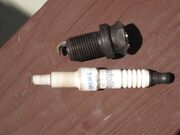
Dissected modern spark plug showing the one-piece sintered alumina insulator. The lower portion is unglazed
Ribs[]
By lengthening the surface between the high voltage terminal and the grounded metal case of the spark plug, the physical shape of the ribs functions to improve the electrical insulation and prevent electrical energy from leaking along the insulator surface from the terminal to the metal case. The disrupted and longer path makes the electricity encounter more resistance along the surface of the spark plug even in the presence of dirt and moisture. Some modern sparking plugs are not manufactured with ribs. Improvements in the dielectric strength of the insulator make them less important.
Insulator tip[]
On modern (post 1930's) spark plugs, the tip of the insulator protruding into the combustion chamber is the same sintered aluminium oxide (alumina) ceramic as the upper portion, merely unglazed. It is designed to withstand 650 °C (1,200 °F) and 60,000 volts.
The dimensions of the insulator and the metal conductor core determine the heat range of the plug. Short insulators are usually "cooler" plugs, while "hotter" plugs are made with a lengthened path to the metal body, though this also depends on the thermally conductive metal core.
Older spark plugs, particularly in aircraft, used an insulator made of stacked layers of mica, compressed by tension in the centre electrode.
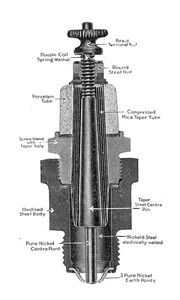
Illustration of compressed mica insulator from 1928.
With the development of leaded petrol in the 1930s, lead deposits on the mica became a problem and reduced the interval between needing to clean the spark plug. Sintered alumina was developed by Siemens in Germany to counteract this.[6] Sintered alumina is a superior material to mica or porcelain because it is a relatively good thermal conductor for a ceramic, it maintains good mechanical strength and (thermal) shock resistance at higher temperatures, and this ability to run hot allows it to be run at "self cleaning" temperatures without rapid degradation. It also allows a simple single piece construction at low cost but high mechanical reliability.
Seals[]
Because the spark plug also seals the combustion chamber or the engine when installed, seals are required to ensure there is no leakage from the combustion chamber. The internal seals of modern plugs are made of compressed glass/metal powder, but old style seals were typically made by the use of a multi-layer braze. The external seal is usually a crush washer, but some manufacturers use the cheaper method of a taper interface and simple compression to attempt sealing.
Metal case[]
The metal case (or the "jacket" as many people call it) of the spark plug withstands the torque of tightening the plug, serves to remove heat from the insulator and pass it on to the cylinder head, and acts as the ground for the sparks passing through the central electrode to the side electrode. Spark plug threads are cold rolled to prevent thermal cycle fatigue. Also, a marine spark plug's shell is double-dipped, zinc-chromate coated metal.[7]
Central electrode[]
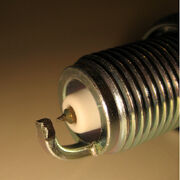
Central and lateral electrodes
The central electrode is connected to the terminal through an internal wire and commonly a ceramic series resistance to reduce emission of RF noise from the sparking. The tip can be made of a combination of copper, nickel-iron, chromium, or noble metals. In the late seventies, the development of engines reached a stage where the ‘heat range’ of conventional spark plugs with solid nickel alloy centre electrodes was unable to cope with their demands. A plug that was ‘cold’ enough to cope with the demands of high speed driving would not be able to burn off the carbon deposits caused by stop-start urban conditions, and would foul in these conditions, making the engine misfire. Similarly, a plug that was ‘hot’ enough to run smoothly in town, could actually melt when called upon to cope with extended high speed running on motorways. The answer to this problem, devised by the spark plug manufacturers, was a centre electrode that carried the heat of combustion away from the tip more effectively than was possible with a solid nickel alloy. Copper was the material chosen for the task and a method for manufacturing the copper-cored centre electrode was created by Floform.
The central electrode is usually the one designed to eject the electrons (the cathode) because it is the hottest (normally) part of the plug; it is easier to emit electrons from a hot surface, because of the same physical laws that increase emissions of vapor from hot surfaces (see thermionic emission). In addition, electrons are emitted where the electrical field strength is greatest; this is from wherever the radius of curvature of the surface is smallest, i.e. from a sharp point or edge rather than a flat surface (see corona discharge). It would be easiest to pull electrons from a pointed electrode but a pointed electrode would erode after only a few seconds. Instead, the electrons emit from the sharp edges of the end of the electrode; as these edges erode, the spark becomes weaker and less reliable.
At one time it was common to remove the spark plugs, clean deposits off the ends either manually or with specialized sandblasting equipment and file the end of the electrode to restore the sharp edges, but this practice has become less frequent for two reasons: 1. cleaning with tools such as a wire brush leaves traces of metal on the insulator which can provide a weak conduction path and thus weaken the spark (increasing emissions) 2. plugs are so cheap relative to labor cost, economics dictate replacement, particularly with modern long-life plugs.
The development of noble metal high temperature electrodes (using metals such as yttrium, iridium, tungsten, or palladium, as well as the relatively high value platinum, silver or gold) allows the use of a smaller center wire, which has sharper edges but will not melt or corrode away. The smaller electrode also absorbs less heat from the spark and initial flame energy. At one point, Firestone marketed plugs with polonium in the tip, under the (questionable) theory that the radioactivity would ionize the air in the gap, easing spark formation.
Side electrode, or ground electrode[]
The side electrode is made from high nickel steel and is welded (or hot forged) to the side of the metal case. The side electrode also runs very hot, especially on projected nose plugs. Some designs have provided a copper core to this electrode, so as to increase heat conduction. Multiple side electrodes may also be used, so that they don't overlap the central electrode.
Spark plug gap[]
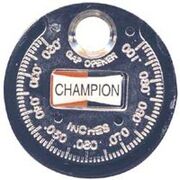
Gap gauge: A disk with sloping edge; the edge is thicker going counter-clockwise, and a spark plug will be hooked along the edge to check the gap.
Spark plugs are typically designed to have a spark gap which can be adjusted by the technician installing the spark plug, by the simple method of bending the ground electrode slightly to bring it closer to or further from the central electrode. The belief that plugs are properly gapped as delivered in their box from the factory is only partially true, as proven by the fact that the same plug may be specified for several different engines, requiring a different gap for each. Spark plugs in automobiles generally have a gap between 0.035"–0.070" (0.9–1.8 mm). But it can depend on the engine: new spark plugs might be pre-gapped for a V-8 engine, installing all 8 plugs unchanged; however if installed in a 6-cylinder engine, all (6) plugs would require re-gapping.
A spark plug gap gauge is a disc with a sloping edge, or with round wires of precise diameters, and is used to measure the gap; use of a feeler gauge with flat blades instead of round wires, as is used on distributor points or valve lash, will give erroneous results, due to the shape of spark plug electrodes. The simplest gauges are a collection of keys of various thicknesses which match the desired gaps and the gap is adjusted until the key fits snugly. With current engine technology, universally incorporating solid state ignition systems and computerized fuel injection, the gaps used are much larger than in the era of carburetors and breaker point distributors, to the extent that spark plug gauges from that era are much too small for measuring the gaps of current cars.
The gap adjustment can be fairly critical, and if it is maladjusted the engine may run badly, or not at all. A narrow gap may give too small and weak a spark to effectively ignite the fuel-air mixture, while a gap that is too wide might prevent a spark from firing at all. Either way, a spark which only intermittently fails to ignite the fuel-air mixture may not be noticeable directly, but will show up as a reduction in the engine's power and fuel efficiency.
With a narrow gap, the spark might be too weak/small to ignite fuel, but the plug will almost always fire on each cycle; a plug with a wide gap might not fire, or missfire at high speeds, but will usually have a spark that is strong for a clean burn. A properly gapped plug will be wide enough to burn hot, but not so wide that it skips or misses at high speeds, causing that cylinder to drag, or the engine to begin to rattle.
As a plug ages, and the metal of both the tip and hook erode, the gap will tend to widen; therefore experienced mechanics often set the gap on new plugs at the engine manufacturer's minimum recommended gap, rather than in the middle of the specified acceptable range, to ensure longer life between plug changes. On the other hand, since a larger gap gives a "hotter" or "fatter" spark and more reliable ignition of the fuel-air mixture, and since a new plug with sharp edges on the central electrode will spark more reliably than an older, eroded plug, experienced mechanics also realize that the maximum gap specified by the engine manufacturer is the largest which will spark reliably even with old plugs and will in fact be a bit narrower than necessary to ensure sparking with new plugs; therefore, it is possible to set the plugs to an extremely wide gap for more reliable ignition in high performance applications, at the cost of having to replace or re-gap the plugs more frequently, as soon as the tip begins to erode.
Variations on the basic design[]

Spark plug with two bottom ground electrodes.
Over the years variations on the basic spark plug design have attempted to provide either better ignition, longer life, or both. Such variations include the use of two, three, or four equally spaced ground electrodes surrounding the central electrode. Other variations include using a recessed central electrode surrounded by the sparkplug thread, which effectively becomes the ground electrode (see "surface-discharge spark plug", below). Also there is the use of a V-shaped notch in the tip of the ground electrode. Multiple ground electrodes generally provide longer life, as when the spark gap widens due to electric distcharge wear, the spark moves to another closer ground electrode. The disadvantage of multiple ground electrodes is that a shielding effect can occur in the engine combustion chamber inhibiting the flame face as the fuel air mixture burns. This can result in a less efficient burn and increased fuel consumption.
Surface-discharge spark plug[]
A piston engine has a part of the combustion chamber that is always out of reach of the piston; and this zone is where the conventional spark plug is located. A Wankel engine has a permanently varying combustion area; and the spark plug is inevitably swept by the tip seals. Clearly, if a spark plug were to protrude into the Wankel's combustion chamber it would foul the rotating tip; and if the plug were recessed to avoid this, the sunken spark might lead to poor combustion. So a new type of "surface discharge" plug was developed for the Wankel. Such a plug presents an almost flat face to the combustion chamber. A stubby centre electrode projects only very slightly; and the entire earthed body of the plug acts as the side electrode. The advantage is that the plug sits just beneath the tip-seal that sweeps over it, keeping the spark accessible to the fuel/air mixture. The "plug gap" remains constant throughout its life; and the spark path will continually vary (instead of darting from the centre to the side electrode as in a conventional plug). Whereas a conventional side electrode will (admittedly, rarely) come adrift in use and potentially cause engine damage, this is impossible with a surface discharge plug, as there is nothing to break off. Surface-discharge spark plugs have been produced by, inter alia, Champion and Bosch.
Sealing to the cylinder head[]

Old spark plug removed from a car, new one ready to install.
Most spark plugs seal to the cylinder head with a single-use hollow or folded metal washer which is crushed slightly between the flat surface of the head and that of the plug, just above the threads. Some spark plugs have a tapered seat that uses no washer. The torque for installing these plugs is supposed to be lower than a washer-sealed plug.
Tip protrusion[]
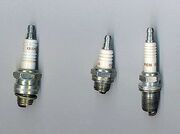
Different sizes of spark plug. The left and right plug are identical in threading, electrodes, tip protrusion, and heat range. The centre plug is a compact variant, with smaller hex and porcelain portions outside the head, to be used where space is limited. The rightmost plug has a longer threaded portion, to be used in a thicker cylinder head.
The length of the threaded portion of the plug should be closely matched to the thickness of the head. If a plug extends too far into the combustion chamber, it may be struck by the piston, damaging the engine internally. Less dramatically, if the threads of the plug extend into the combustion chamber, the sharp edges of the threads act as point sources of heat which may cause preignition; in addition, deposits which form between the exposed threads may make it difficult to remove the plugs, even damaging the threads on aluminium heads in the process of removal. The protrusion of the tip into the chamber also affects plug performance, however; the more centrally located the spark gap is, generally the better the ignition of the air-fuel mixture will be, although experts believe the process is actually much more complex and dependent on combustion chamber shape. On the other hand, if an engine is "burning oil", the excess oil leaking into the combustion chamber tends to foul the plug tip and inhibit the spark; in such cases, a plug with less protrusion than the engine would normally call for often collects less fouling and performs better, for a longer period. In fact, special "antifouling" adapters are sold which fit between the plug and the head to reduce the protrusion of the plug for just this reason, on older engines with severe oil burning problems; this will cause the ignition of the fuel-air mixture to be less effective, but in such cases, this is of lesser significance.
Heat range[]
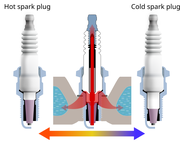
Construction of hot and cold spark plugs - a longer insulator tip makes the plug hotter
The operating temperature of a spark plug is the actual physical temperature at the tip of the spark plug within the running engine. This is important because it determines the efficiency of plug self-cleaning and is determined by a number of factors, but primarily the actual temperature within the combustion chamber. There is no direct relationship between the actual operating temperature of the spark plug and spark voltage. However, the level of torque currently being produced by the engine will strongly influence spark plug operating temperature because the maximum temperature and pressure occurs when the engine is operating near peak torque output (torque and RPM directly determine the power output). The temperature of the insulator responds to the thermal conditions it is exposed to in the combustion chamber but not vice versa. If the tip of the spark plug is too hot it can cause pre-ignition or sometimes detonation/knocking and damage may occur. If it is too cold, electrically conductive deposits may form on the insulator causing a loss of spark energy or the actual shorting-out of the spark current.
A spark plug is said to be "hot" if it is a better heat insulator, keeping more heat in the tip of the spark plug. A spark plug is said to be "cold" if it can conduct more heat out of the spark plug tip and lower the tip's temperature. Whether a spark plug is "hot" or "cold" is known as the heat range of the spark plug. The heat range of a spark plug is typically specified as a number, with some manufacturers using ascending numbers for hotter plugs and others doing the opposite, using ascending numbers for colder plugs.
The heat range of a spark plug (i.e. in scientific terms its thermal conductivity characteristics) is affected by the construction of the spark plug: the types of materials used, the length of insulator and the surface area of the plug exposed within the combustion chamber. For normal use, the selection of a spark plug heat range is a balance between keeping the tip hot enough at idle to prevent fouling and cold enough at maximum power to prevent pre-ignition or engine knocking. By examining "hotter" and "cooler" spark plugs of the same manufacturer side by side, the principle involved can be very clearly seen; the cooler plugs have a more substantial ceramic insulator filling the gap between the center electrode and the shell, effectively allowing more heat to be carried off by the shell, while the hotter plugs have less ceramic material, so that the tip is more isolated from the body of the plug and retains heat better.
Heat from the combustion chamber escapes through the exhaust gases, the side walls of the cylinder and the spark plug itself. The heat range of a spark plug has only a minute effect on combustion chamber and overall engine temperature. A cold plug will not materially cool down an engine's running temperature. (Too hot of a plug may, however, indirectly lead to a runaway pre-ignition condition that can increase engine temperature.) Rather, the main effect of a "hot" or "cold" plug is to affect the temperature of the tip of the spark plug.
It was common before the modern era of computerized fuel injection to specify at least a couple of different heat ranges for plugs for an automobile engine; a hotter plug for cars which were mostly driven slowly around the city, and a colder plug for sustained high speed highway use. This practice has, however, largely become obsolete now that cars' fuel/air mixtures and cylinder temperatures are maintained within a narrow range, for purposes of limiting emissions. Racing engines, however, still benefit from picking a proper plug heat range. Very old racing engines will sometimes have two sets of plugs, one just for starting and another to be installed once the engine is warmed up, for actually driving the car.
Spark plug manufacturers use different numbers to denote heat range of their spark plugs.
Reading spark plugs[]
The spark plug's firing end will be affected by the internal environment of the combustion chamber. As the spark plug can be removed for inspection, the effects of combustion on the plug can be examined. An examination, or "reading" of the characteristic markings on the firing end of the spark plug can indicate conditions within the running engine. The spark plug tip will bear the marks as evidence of what is happening inside the engine. Usually there is no other way to know what is going on inside an engine running at peak power. Engine and spark plug manufacturers will publish information about the characteristic markings in spark plug reading charts. Such charts are useful for general use but are of almost no use in reading racing engine spark plugs, which is an entirely different matter.
A light brownish discoloration of the tip of the block indicates proper operation; other conditions may indicate malfunction. For example, a sandblasted look to the tip of the spark plug means persistent, light detonation is occurring, often unheard. The damage that is occurring to the tip of the spark plug is also occurring on the inside of the cylinder. Heavy detonation can cause outright breakage of the spark plug insulator and internal engine parts before appearing as sandblasted erosion but is easily heard. As another example, if the plug is too cold, there will be deposits on the nose of the plug. Conversely if the plug is too hot, the porcelain will be porous looking, almost like sugar. The material which seals the central electrode to the insulator will boil out. Sometimes the end of the plug will appear glazed, as the deposits have melted.
An idling engine will have a different impact on the spark plugs than one running at full throttle. Spark plug readings are only valid for the most recent engine operating conditions and running the engine under different conditions may erase or obscure characteristic marks previously left on the spark plugs. Thus, the most valuable information is gathered by running the engine at high speed and full load, immediately cutting the ignition off and stopping without idling or low speed operation and removing the plugs for reading.
Spark plug reading viewers, which are simply combined flashlight/magnifiers, are available to improve the reading of the spark plugs.
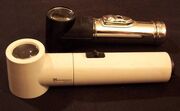
Two spark plug viewers
Indexing spark plugs[]
A matter of some debate is the "indexing" of plugs upon installation, usually only for high performance or racing applications; this involves installing them so that the open area of the spark gap, not shrouded by the ground electrode, faces the center of the combustion chamber, towards the intake valve, rather than the wall. Some engine tuners[who?] believe that this will maximize the exposure of the fuel-air mixture to the spark, also ensuring that every combustion chamber is an even in layout and therefore result in better ignition ; others, however, believe that this is useful only to keep the ground electrode out of the way of the piston in ultra-high-compression engines if clearance is insufficient. In any event, this is accomplished by marking the location of the gap on the outside of the plug, installing it, and noting the direction in which the mark faces; then the plug is removed and additional washers are added so as to change the orientation of the tightened plug. This must be done individually for each plug, as the orientation of the gap with respect to the threads of the shell is random. Some plugs are made with a non-random orientation of the gap and are usually marked as such by a suffix to the model number; typically these are specified by manufacturers of very small engines where the spark plug tip and electrodes form a significantly large part of the shape of the combustion chamber. The Honda Insight has indexed spark plugs from factory, with four different part numbers available corresponding to the different degrees of indexing to achieve most efficient combustion and maximum fuel efficiency.
See also[]

Spark plug collection (part)
- François Isaac de Rivaz circa 1807 he invented a hydrogen and oxygen powered internal combustion engine with electric ignition.
- Étienne Lenoir In 1886, he patented, among internal combustion engine improvements, the first modernly recognizable spark plug[8] shown as figure #6 here:.[9]
- Ignition system
- Wasted spark
- Ignitor
- Glowplug
- Glow plug (model engine)
References[]
- ↑ The Bosch book of the Motor Car, Its evolution and engineering development, St. Martin's Press, copyright 1975, Library of Congress # 75-39516, pp 206-207.
- ↑ "A.S.E.C.C.`s History of Spark Plugs". Asecc.com (1927-10-27). Retrieved on 2011-09-17.
- ↑ "Lodge Plugs". Gracesguide.co.uk (2011-08-30). Retrieved on 2011-09-17.
- ↑ "Denso's "Basic Knowledge" page". Globaldenso.com. Retrieved on 2011-09-17.
- ↑ The Bosch Automotive Handbook, 8th Edition, Bentley Publishers, copyright May 2011, ISBN 978-0-8376-1686-5, pp 581-585.
- ↑ Air Commodore F. R. Banks (1978). I Kept No Diary. Airlife, 113. ISBN 0-9504543-9-7.
- ↑ Marine Engine Digest: Marine Spark Plug Savvy[dead link]
- ↑ "Madehow.com's "How a spark plug is made" page". madehow.com.
- ↑ "1886 Gas Engine patent #345,596 for Ettienne Jean Joseph Lenoir".
External links[]
| Wikibooks has a book on the topic of |
- Spark plug condition and fault diagnosis
- "Here's How A Spark Plug Works", November 1945, Popular Science
| |||||||||||||||||||||||||||||||||||
| ||||||||||||||||||||
| This page uses some content from Wikipedia. The original article was at Spark plug. The list of authors can be seen in the page history. As with Tractor & Construction Plant Wiki, the text of Wikipedia is available under the Creative Commons by Attribution License and/or GNU Free Documentation License. Please check page history for when the original article was copied to Wikia |